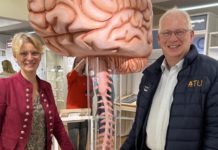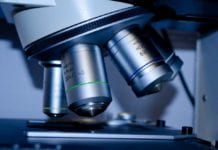A team of scientists at University of Galway have discovered a remarkably well-preserved group of fossil sea urchins on a limestone slab in Co. Wexford.
The fascinating discovery was first made by Dr Nidia Álvarez Armada when she was surveying the geology at Hook Head for her undergraduate thesis at University of Galway.
Over 200 complete fossil sea urchins are preserved in exquisite detail on the slab, in an area of just 1m2.

The limestone layer containing the fossils was in danger of being lost to coastal erosion, so the scientific team mounted a rescue operation to save it.
They successfully removed the slab and entrusted it to the National Museum of Ireland for conservation and further study.
The site at Hook Head is protected under law and approval for the recovery was granted by several state agencies, as well as the local landowner.
All of the sea urchins have their spines still attached, and they apparently died together on the seafloor almost 350 million years ago – a dramatic moment now frozen in time on the rock surface on the coast of south-east Ireland.
The fossil find could reveal important information about the nature of seafloor communities during the Carboniferous, a time period that occurred long before dinosaurs ever walked on land.

Palaeontologist Dr Nidia Álvarez Armada, the lead author in the study, said that when she first noticed the echinoids on the limestone surface, she was “completely astonished” by both the sheer number of fossil specimens and their exceptional preservation.
“The significance of the find was instantly apparent and I immediately began mapping and recording the shape, size and position of each individual urchin on the rock surface,” said Dr Álvarez Armada.
“This work took several weeks to complete, but it was important to carefully document the fossil find in as much detail as possible.”
Dr John Murray, who co-authored the paper and supervised the original project, said it is quite exceptional to find Carboniferous fossil sea urchins so perfectly preserved and in such large numbers like this.
“In life, these particular echinoids had very flexible plated bodies, covered with many spines, which usually disarticulated and dispersed rapidly after death, leaving little trace of them behind,” he said.
“The Hook Head urchins must have been buried quite quickly after they died, with little or no post mortem disturbance; however, it remains unclear why they congregated in such large numbers at this location on that ancient seafloor.”
Dr Murray added that the significance of this discovery was such that all of the members of the rescue team willingly volunteered their time and expertise to travel to Hook Head to help salvage the fossil-bearing slab.
“We consciously chose to leave this important fossil find in the care of the National Museum of Ireland immediately – I guess it was our way of giving this piece of priceless geoheritage back to the people of Ireland.”











